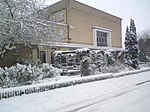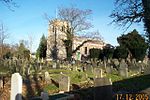Edgware & Hendon Reform Synagogue
Edgware & Hendon Reform Synagogue, a member of the Movement for Reform Judaism, is a Reform Judaism congregation at 118 Stonegrove, Edgware in the London Borough of Barnet. It was formed in 2017 as a result of the merger between the Edgware & District Reform Synagogue (EDRS) and the Hendon Reform Synagogue (HRS) communities. EDRS originated in 1934 as "Edgware and District Progressive Jewish Fellowship" and in February 1935 became “Edgware and District Reform Synagogue”. HRS was founded in 1949 and its first building, in 1955, was in Danescroft Avenue. The two communities merged in 2017, and the merged community is located on the site of the former EDRS. It is now the largest synagogue in Europe; its membership includes 2500 families. The senior rabbi is Mark Goldsmith. He succeeded Danny Smith, who retired in summer 2019.
Excerpt from the Wikipedia article Edgware & Hendon Reform Synagogue (License: CC BY-SA 3.0, Authors).Edgware & Hendon Reform Synagogue
Stonegrove, London
Geographical coordinates (GPS) Address External links Nearby Places Show on map
Geographical coordinates (GPS)
| Latitude | Longitude |
|---|---|
| N 51.6189 ° | E -0.2887 ° |
Address
Edgware and District Reform Synagogue
Stonegrove 118
HA8 8AB London (London Borough of Barnet)
England, United Kingdom
Open on Google Maps









